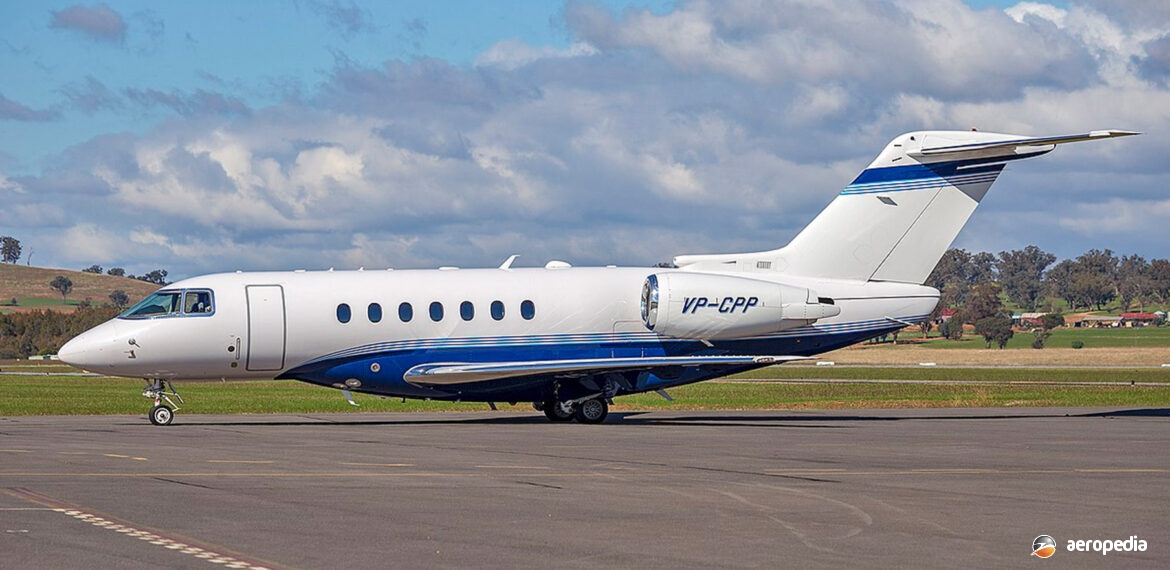Photograph:
Hawker 4000 CP-CPP (c/n 7625) at Wagga Wagga, NSW, in May 2019 (Robert Myers)
Country of origin:
United States of America
Description:
Business and executive aircraft
Power Plant:
Two 6,900 lbst Pratt & Whitney (Canada) PW308A turbofans
Specifications:
- Wingspan: 18.82 m (61 ft 9 in)
- Length: 21.18 m (69 ft 6 in)
- Height: 6.02 m (19 ft 9 in)
- Wing area cruising speed at Mach: 0.78 – 809 km/h (503 mph)
- Cruising speed at Mach 0.84 – 893 km/h (555 mph): at 13,106 m (43,000 ft)
- Time to climb to 11,278 m (37,000 ft): 14 mins
- Certified ceiling: 13,716 m (45,000 ft)
- Service ceiling: 13,137 m (43,100 ft)
- Single-engine ceiling: 8,656 m (28,400 ft)
- Ferry range with zero payload and 5,760 kg (12,699 lb) fuel at 809 km/h (503 mph): 5,941 km (3,692 miles)
- Range with 1,134 kg (2,500 lb) payload: 5,287 km (3,285 miles)
- Take-off field length: 1,585 m (5,200 ft)
- Fuel capacity: 6,622 kg (14,600 lb) – 8,251 litres (1,815 Imp gals)
- Empty weight: 10,342 kg (22,800 lb)
- Max payload: 1,134 kg (2,500 lb)
- Max payload with full fuel: 726 kg (1,600 lb)
- Useful load: 7,348 kg (16,200 lb); 17,917 kg (39,500 lb)
History:
Initially known as the Hawker Horizon, the Hawker Beechcraft 4000 (formerly Raytheon) was announced in 1996, the prototype making its first flight on 11 August 2001. However, the company had some early problems with certification and production did not commence until 2006. These problems were related to the revolutionary composite barrel fuselage that had been designed, but there were also some problems with hydraulics, the fuel system, and insufficient lightning strike insulation of electrical components. After much work provisional certification was obtained in December 2004, full certification being received in November 2006 under Part 25 transport category aircraft.
By early 2007 orders for 130 aircraft had been received, the largest being from the European ownership management company, NetJets, which placed an order for 50 examples in December 2005, this being increased by a further order for 32 in May 2007. By 2009 production is expected to reach 30 aircraft per year. Accommodation is provided for a crew and eight passengers, but up to 14 may be carried.
The 4000 is able to reach cruise altitude of 11,278 ft (37,000 ft) in 14 minutes, cruise at Mach 0.82 with eight passengers and full fuel, and had a trans-continental range of 5,740 km (3,567 miles). Cruising at Mach 0.77 the range is increased to 6,300 km (3,915 miles). The fuselage is constructed of woven laminated graphite-epoxy and honeycomb materials. The wings are conventional metal and are manufactured by Fuji Heavy Industries in Japan. Engines are Pratt & Whitney PW308A turbofans with full FADEC control and are fitted with Nordam thrust reversers. In the cockpit is a Honeywell Primus EPIC avionics suite with five colour LCDE displays.
The first of the type seen in this region was N15QS, a manufacturers pre-production test demonstrator which made a sales tour which visited Darwin, Brisbane and Sydney, in September 2007. First of the type for operations in this region was ordered by a New Zealand operator. Delivery was expected to be taken in May 2008 but it seems it was not imported.
A further example registered CP-CPP (c/n 7625) registered in the Cayman Islands was operated for some time in Australia by Queensland politician and businessman Clive Palmer, Mr Palmer owning a number of companies, including Mineralogy, Waratah Coal, and Queensland Nickel at Townsville. In late 2020 it was announced the aircraft was to be retired.

